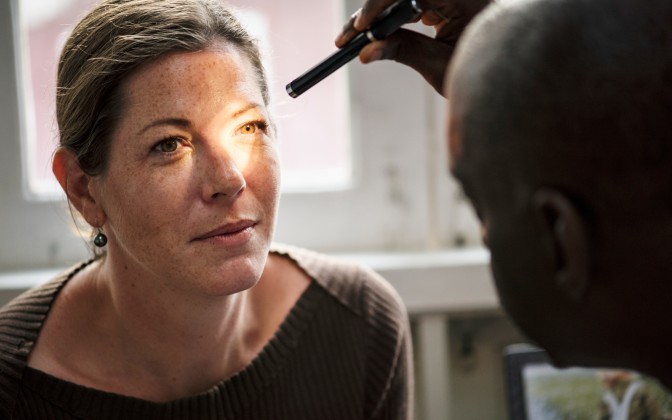Buy one pair of eyeglasses, get a second pair 50% off!
*Restrictions apply. Click here for details.

Can Your Eyes Change Color? Debunking Myths & Exploring Medical Conditions
Have you ever noticed that your eye color appears to shift depending on what you're wearing or your mood? Or perhaps someone has mentioned that your eyes can change color. Is this truly possible, or is it just a myth?
The answer is both yes and no. While the color of healthy adult eyes typically remains stable, various factors can create the illusion of a color change. Most "changes" in eye color are due to lighting, your pupil size, or other environmental factors. However, a sudden or permanent change in eye color could indicate a medical issue, such as an eye injury, disease, or a reaction to certain medications. If you notice any significant changes in your eye color, it’s important to make an appointment with your eye care professional.
Let’s take a deeper dive into the science behind eye color and explore what might cause it to change.
What Determines Your Eye Color?
Eye color is primarily determined by a pigment called melanin. This pigment is concentrated in the iris, the circular part of your eye surrounding the pupil, which controls the amount of light that enters the eye. The more melanin present in the iris, the darker the eye color will be. As a result, people with brown eyes have higher melanin levels, while those with blue or green eyes have less melanin.
The amount of melanin in your eyes is inherited through your genes. Various genes are responsible for determining eye color, and these same genes can influence other physical traits, like your skin and hair color.
Your parents’ eye colors play a significant role in determining your own. For example, if both parents have blue eyes, it’s likely that their child will have blue eyes too. However, if one parent has blue eyes and the other has brown, the child’s eye color becomes less predictable.
It’s also possible for a child’s eye color to differ from their parents’ due to other genetic influences. For example, a child of two brown-eyed parents may inherit blue eyes if their grandparents had blue eyes.
For parents curious about their newborn's eye color, it’s worth noting that a baby’s eye color can change over time. In the first few months, a baby’s eyes may darken as melanin production continues. This process happens because melanocytes, the cells responsible for producing melanin, remain active in the eyes for several months after birth.
Temporary vs. Permanent Eye Color Changes: Exploring Potential Explanations
While significant changes in eye color are rare for adults, some minor shifts can occur over time. For instance, prolonged sun exposure may cause your eyes to darken slightly, and in certain individuals, eyes can lighten with age. However, in most cases, your eye color will remain largely unchanged, and any substantial change should be investigated, as it could indicate an underlying health issue.
There are various factors that may cause your eye color to appear different or seem to change temporarily. Let’s explore some of the common causes and how they differ from permanent changes.

Common Explanations for Changes in Eye Color
Medical Reasons for Changes in Eye Color
While most changes in eye color are related to genetic factors, there are certain medical conditions that can alter the appearance of your eyes. Here are a few conditions that may cause changes in eye color:
Eye Injury
A direct injury to the eye, such as a blunt force trauma, penetrating injury, or chemical burn, can disrupt the iris tissue or the small blood vessels that nourish it, leading to noticeable changes in eye color. This could manifest in two ways:
Iron deposits (siderosis) or calcium deposits (chalcosis) can form on the iris, causing a reddish-brown or white appearance.
Thinning of the iris tissue can allow more light to reflect from the underlying layer of the eye, making the eye appear lighter.
If the color shift persists after an injury, it may indicate hidden issues like angle-recession glaucoma or retained foreign bodies. Any eye injury, especially if it results in a color change, should be evaluated by an eye doctor promptly to avoid further complications.
Lisch Nodules
Lisch nodules are small, brown bumps that appear on the iris. These nodules are often associated with neurofibromatosis, a genetic disorder that affects nerve tissue growth. While Lisch nodules typically do not affect vision, a cluster of these nodules can cause the iris to appear darker or speckled, particularly in individuals with blue or green eyes. Neurofibromatosis requires ongoing medical management, so it’s important to seek professional care.
Fuchs Heterochromic Iridocyclitis (FHI)
Fuchs Heterochromic Iridocyclitis (FHI) is a rare form of eye inflammation that affects the iris. This condition often leads to a loss of pigmentation in the iris, which can cause a noticeable change in eye color. In addition to changing eye color, FHI may also cause cataracts, and if untreated, it can lead to glaucoma. Because its symptoms are often subtle, FHI may not be diagnosed until vision problems such as blurred vision or increased intraocular pressure occur.
Changes in Color Due to Medication
Certain medications used to treat glaucoma, such as prostaglandin analogs (e.g., latanoprost, bimatoprost, travoprost, and unoprostone), can cause a gradual darkening of the eye color. This color change is typically harmless, but it can be permanent. It often occurs when the medication is used in only one eye, and although it is not medically concerning, it’s important to discuss any concerns with your doctor to weigh the risks and benefits of continuing treatment.
Horner’s Syndrome
Horner’s syndrome is a rare condition that can result from nerve damage, often caused by a stroke or injury. It affects the sympathetic nervous system, impacting the iris and pupil. One of the visual effects of Horner’s syndrome is that the affected pupil may appear larger or smaller than the other, which can make the eye color seem different. In addition to affecting the appearance of eye color, Horner’s syndrome can also lead to iris depigmentation.
Iridocorneal Endothelial Syndrome (ICE)
ICE syndrome is a rare disorder in which cells from the cornea (the clear outer layer of the eye) migrate to the iris. This can lead to spots or other irregularities on the iris, affecting its color. The condition can also cause increased pressure in the eye, resulting in secondary glaucoma that may require surgical treatment. ICE syndrome often presents as a subtle change in eye color, typically in middle-aged women, and it can lead to more serious complications if left untreated.
Cosmetic Eye Color Changes
If you're looking to temporarily alter your eye color for aesthetic reasons, there are several safe options available. Unlike permanent changes caused by medical conditions, these cosmetic solutions offer a reversible way to achieve a new eye color.
Prescription Colored Contact Lenses: Colored contact lenses are an excellent option for altering your eye color temporarily. These lenses come in a variety of shades and can either enhance your natural eye color or create a completely new look. It’s important to ensure that your colored lenses are properly fitted and cleaned to avoid irritation or damage. Always follow your eye care professional’s instructions regarding the wear and care of these lenses.
Makeup and Lighting: If you prefer to avoid contact lenses, there are makeup tricks and lighting techniques that can help you enhance or alter the appearance of your eyes. For example, warm-toned eyeshadows like gold or copper can make brown eyes appear more vibrant, while plum or green shades can bring out the flecks in hazel or green eyes. Using lighting, such as soft-box lights, can intensify the natural color of your eyes in photos, and digital filters can be used to change eye color for online images and videos.

Frequently Asked Questions About Eye Color Changes
Noticing Changes in Eye Color? Schedule an Eye Exam Today
While most people's eye color remains stable after infancy, sudden or noticeable changes in eye color may signal an underlying issue. If you notice a significant or rapid change in your eye color, it’s important to schedule an appointment with an eye care professional as soon as possible.
The experts at Clarkson Eyecare are here to help you understand what might be causing a change in your eye color and to ensure your eye health is well-managed. Contact us today to find a location near you and schedule an eye exam. Your vision and health are our priority!
